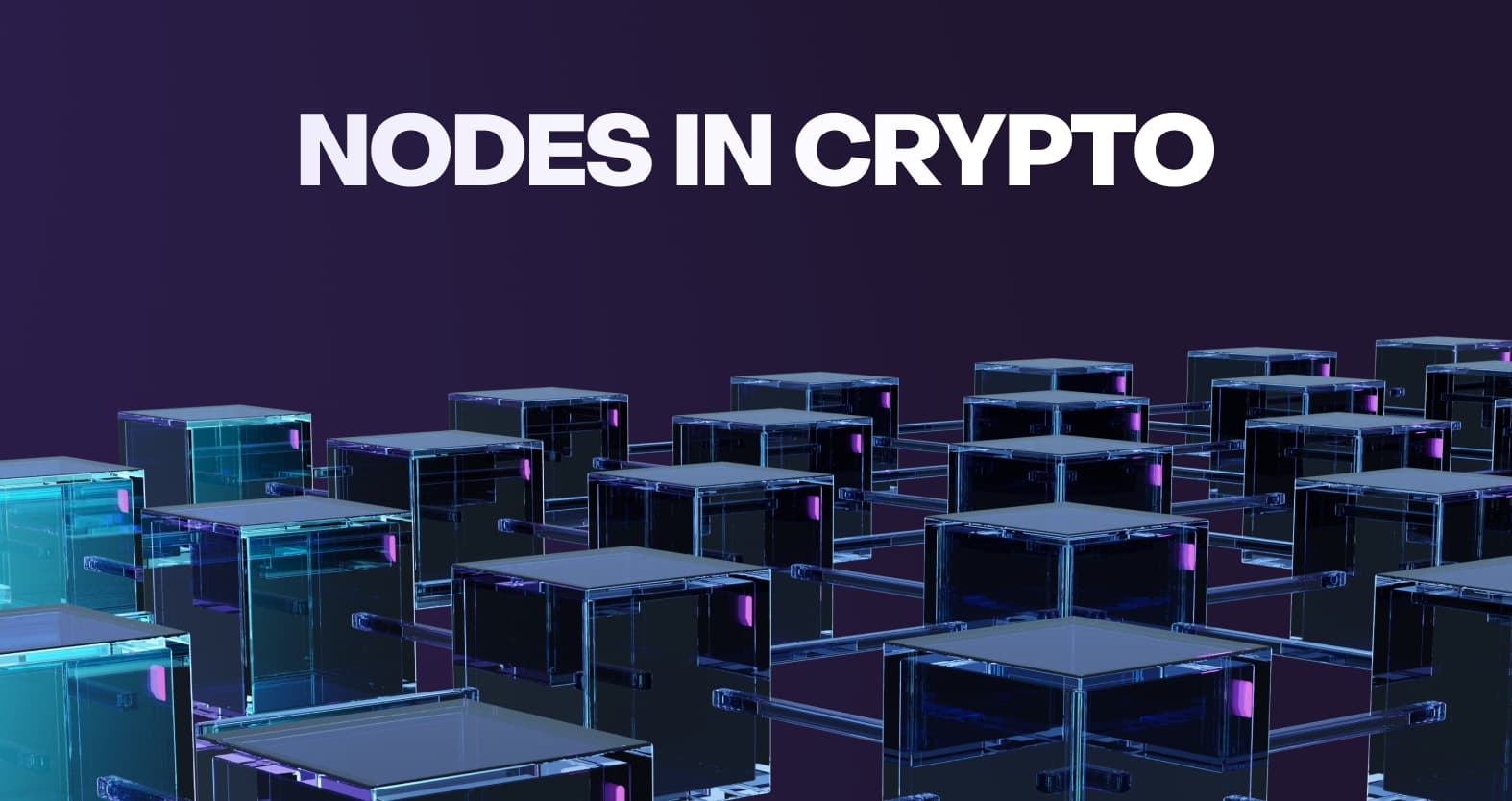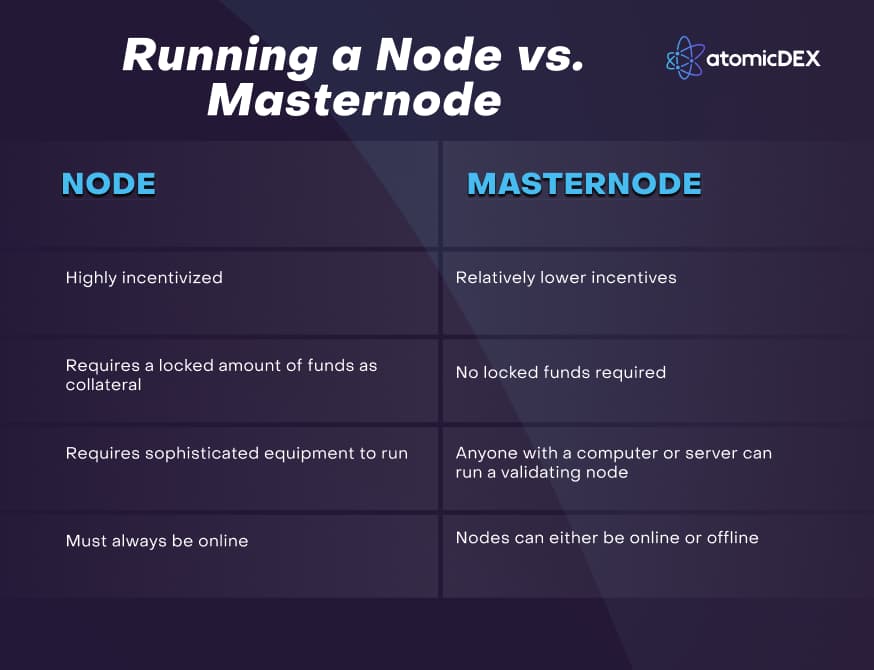
Table of contents
A node connects to a cryptocurrency's blockchain network to record or validate transactions. Nodes process and store data on all blockchain transactions and protect the network's security and integrity through decentralized governance.
Participants on a blockchain network have unique roles that serve different purposes to maintain the network's security, usability, and decentralization. To exchange any crypto asset, users must relay the transactions through participating network points to confirm and process the interactions. These points are called 'nodes' and are the backbone of any blockchain network.
What Are Nodes in Crypto?
Nodes are an essential part of any blockchain network. They are network participants on a blockchain that either distribute data to other nodes or function as network endpoints. On a blockchain, the nodes are usually a physical network of devices, such as computers, laptops, or servers.
Blockchain nodes perform various functions, including validating or rejecting a block of transactions. Nodes are also responsible for recording the history of each block of transactions and can send the stored transaction history to other nodes on the network for safekeeping and future reference.
Functions of Nodes
The essential functions of nodes on a blockchain depend on their type and network role. A blockchain node can:
- Accept or reject a transaction
- Authenticate and manage a transaction
- Store and encrypt transaction data in a block
- Act as a point of communication with other nodes of the particular blockchain
Blockchain networks are composed of different types of nodes with role-specific functionalities. For instance, some nodes exclusively validate transactions, while others only keep a record of transactions. Nodes are classified into two categories based on availability.
"Online nodes" are always active and continuously send transaction history updates to the network. The other category is "offline nodes," which are not always connected to the network. When connected, an offline node must download and update a copy of the ledger to remain in sync with the blockchain.
Types of Crypto Nodes
Although the various types of blockchain nodes function differently, they all share a core responsibility to improve network security, privacy, and usability. The following are the most critical types of blockchain nodes:
Full Nodes
Full nodes act as validation servers in decentralized networks. Their primary roles include maintaining the consensus between other nodes and verifying transactions. They contain the complete and up-to-date data and history of every block since the first transaction occurred on the network. Full nodes consume a lot of data and may require immense computing power for processing (like in the case of Bitcoin nodes). A highly decentralized blockchain network has thousands of full nodes working together at any time.
Supernodes
The core responsibility of supernodes is to aid the interconnection of full nodes and help spread information across the network to ensure that participants have accurate data. Supernodes offer transaction validation, authorization, gateway services, and network support. Besides their typical roles, supernodes also facilitate voting events, compliance with blockchain regulations, and execution of protocol events. Although they handle offline functionalities, supernodes are generally always online.
Unlike other nodes, supernodes require much more power and resources to run. As a result of incurred overhead costs, operators of supernodes receive compensation in the form of tokens and coins. However, operators must provide crypto collateral to run supernodes.
Mining Nodes
Miners are responsible for adding transactions to the blockchain and are rewarded for performing this extremely vital function. Since this is potentially lucrative, many mining nodes compete to add transactions to the blockchain. In terms of Proof of Work miners, like the ones used to validate the Bitcoin network, participants must solve complex mathematical puzzles using specific hardware components.
The mining node that completes the tasks then broadcasts the results to the network for verification by full nodes. Ethereum, the second most popular blockchain, has moved to Proof of Stake verification, with a now differing node verification mechanism. Once verified, the network grants the miner the right to add a block to the blockchain and rewards them in the native token of the network.
Lightweight (SPV) Client
Another type of blockchain node used in crypto operations is the lightweight node or Simple Payment Verification (SPV) client. SPV clients communicate with the blockchain but rely on full nodes to provide them with necessary information. Therefore, SPV clients do not keep a copy of blockchain transaction data and are not responsible for the network's security.
Additionally, SPV clients do not participate in a network's verification and validation processes. A lightweight node is typically a small piece of software that does not require a lot of storage or resources.
Full Node Vs. Mining Nodes
It is noteworthy to outline the main difference between a mining node and a full node. Anyone who wants to run a full mining node requires expensive mining hardware and software. In contrast, running a full validating node takes significantly fewer resources.
Before attempting to mine a block, a miner must gather all pending network transactions previously validated by the full nodes. A mining node must also solve a complex cryptographic problem to process additions to the blockchain. After successfully solving the problem, full nodes (not other miners) validate the solution through a consensus model.
Masternodes
Unlike full nodes, masternodes cannot add new blocks to a blockchain. However, they perform several other functions besides keeping complete blockchain records and relaying transactions to other nodes.
Some masternode functions include:
- Increasing the privacy of transactions
- Facilitating instant transactions
- Participating in governance and voting
- Enable budgeting and treasury systems for cryptocurrencies
Running a Node vs. Running a Masternode
Masternodes have increased capabilities that make them significantly different from standard network nodes. Some of the key differences include the following:

Anyone Can Run a Cryptocurrency Node
In traditional finance, most payment solutions rely on centralized or third-party administration. However, blockchain technology introduced decentralized control of funds with cryptocurrencies.
Blockchains use nodes to check and verify other nodes through a consensus mechanism, thereby eliminating the need for third-party authorities. Through this decentralization, anyone with an internet connection can set up a node by downloading a blockchain's software onto their personal computer and running it from anywhere in the world.
Try AtomicDEX — Hold and Trade Cryptocurrencies
AtomicDEX is a non-custodial wallet, cross-chain/protocol bridge, and cross-chain/protocol decentralized exchange rolled into one app.
Start using AtomicDEX wallet to hold and trade Bitcoin (BTC), Ethereum (ETH) and ERC-20 tokens, Binance Coin (BNB) and BEP-20 tokens, Dogecoin (DOGE), and many other cryptocurrencies all from one app.




